The Battle of White Sulphur Springs (12 page)
Read The Battle of White Sulphur Springs Online
Authors: Eric J. Wittenberg

A postwar image of Captain Edmund S. Read, who commanded a company of the 26
th
Battalion Virginia Infantry.
Terry Lowry
.
Patton and his staff sat on a nearby knoll, watching Edgar's battalion fend off the initial Federal attacks. Seeing Averell's initial assaults fall back, Patton exclaimed, “Glorious! Hurrah for the gallant Edgar!” and then asked his adjutant, Lieutenant Noyes Rand, to
carry
his compliments to Edgar. Rand deferred to Lieutenant Colonel David S. Hounshell, who was temporarily serving as a volunteer aide that day. Hounshell rode deliberately across and toward the line of fire in a diagonal direction, “as if on dress parade,” as Rand remembered it. Edgar rose to receive the message, exposing himself to heavy enemy fire as he did so. “None of us of the Staff envied Edgar the ordeal of receiving a set speech under a rain of bullets.”
211
Soon after daylight, while they were about a mile and a half from Dry Creek, a courier from Colonel Patton reached Captain Beirne Chapman, bearing a dispatch. After reading the urgent message, Chapman ordered his men forward at the double-quick, “as fast as horses could trot with a battery.” They arrived at the intersection of the Anthony's Creek road and the turnpike just as Averell's line of battle began advancing.
212
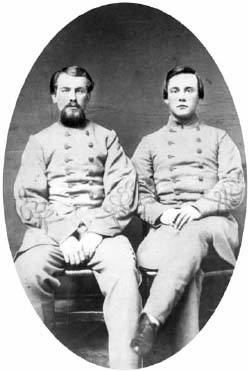
Lieutenant John P. Donaldson and Adjutant Noyes Rand of the 22
nd
Virginia Infantry. Rand served as Colonel Patton's adjutant when Patton was in brigade command.
Louise Testerman Collection, Virginia Polytechnic Institute
.
The Confederate artillery was located on the high ground to the left, and the Union artillery was located on the high ground to the right.
West Virginia State Archives
.
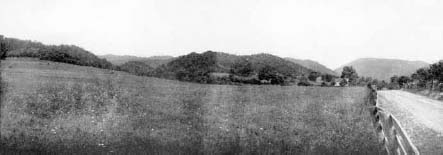
Patton ordered up the four guns of Chapman's battery and deployed them to the left of the Anthony's Creek road and on a knoll behind Edgar's battalion. The Southern gunners opened at the advancing Federals, scattering von König's scouting parties. “We immediately opened on their columns,” reported Chapman, “firing slowly and deliberately.”
213
Sergeant John G. Stevens, one of Chapman's artillerists, proudly recalled, “Chapman's battery opened fire at once, and was given the credit of holding back the enemy long enough for our infantry to form in line of battle. I never saw our men so greatly excited, while we were getting into position shells were bursting among us, and the minie [
sic
] balls singing like August crickets.”
214
Captain Read then ordered his company to charge, and some did, but “most of them thought to let well enough alone,” recalled C.W. Humphreys of Company B. “So he and those of us who followed him walked quietly back, our captain coolly remarking, âIt was not as good a place as I thought it was.'” Humphreys, in a masterpiece of understatement, agreed. “It certainly was not a good place,” he said. Read then pulled his company back to his left rear, leaving a gap between them and the road for the deployment of Company H of the 22
nd
Virginia. “There was a deep hollow in our front, as we took position behind a fence that ran down a lone ridge,” recalled Humphreys. “In our immediate rear was a steep place, at the foot of which was cleared land extending back some two hundred yards. We were in this position when the storm broke loose.”
215
Patton also ordered the 22
nd
and 45
th
Virginia Regiments to come up and form a line of battle, with the 22
nd
on the left of the battery and the 45
th
on the right.
216
Patton ordered both regiments to hold their positions at all costs, since they represented the center of the Confederate line.
217
When the 45
th
Virginia deployed, Edgar pulled back one of Woodram's companies and placed it on his left, leaving only three companies with Woodram on the right.
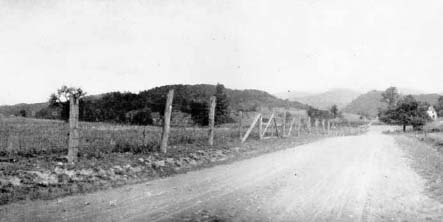
The Confederate viewpoint as Patton's brigade approached the battlefield.
West Virginia State Archives
.
The 45
th
Virginia extended its line across the low ground to the base of the ridge on the right. Captain William H. Thompson led one hundred men of the 45
th
Virginia to occupy a knoll to the right of the main line of battle that Patton was cobbling together. Colonel William H. Browne, commander of the 45
th
Virginia, had his men throw up a hasty barricade of fence rails, and they took position behind it.
218
Hearing the firing break out at the intersection ahead, Averell immediately started his entire column forward at “a rapid gait” down into and through the narrow gorge of Rocky Gap. The whole column advanced “as rapidly as the nature of the ground would permit,” noted one of Averell's men.
219
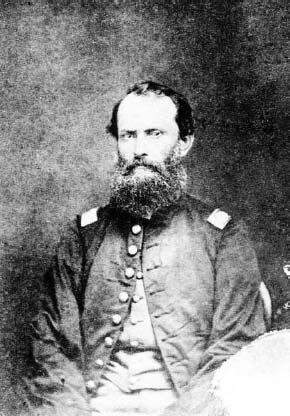
Captain Francis Mathers of the 8
th
West Virginia Mounted Infantry.
West Virginia State Archives
.
“We found a little grove of sugar trees and dismounted and appointed details to hold the horses,” recalled Captain Francis Mathers of the 8
th
West Virginia. “Our regiment was ordered to charge upon the rebels on the left, and dislodge them from that position,” while the 2
nd
and 3
rd
West Virginia and 14
th
Pennsylvania attacked on the right.
220
“Thus formed, the federal soldiers sent the messengers of death among the rebels like hail stones and fire,” colorfully noted a member of the 3
rd
West Virginia a few days after the battle.
221
“The fight soon became general and terrific,” remembered a member of the 3
rd
West Virginia. “Balls, shells, grape and shot flying with fearful havoc in all directions, doing the work of death. The whole atmosphere resounds with the roar of artillery and musketryâ¦For four or five hours I believe there was not an intermission of more than two minutes at any one timeâalmost an incessant fire.”
222
William Marshall Dearing served in Company F, 3
rd
West Virginia. When Chapman's gunners opened on their advance, a Confederate cannonball rolled down the hill, headed directly for Dearing's position. The man next to Dearing thought he could stop the cannonball by just sticking his foot out. The man stuck his foot out, but his doing so not only failed to stop the cannonball's momentum but also snapped the man's foot in two, causing him to collapse, shrieking in agony. Dearing and another soldier dragged the injured man back to safety while under heavy enemy fire. When they advanced again, the men of the 3
rd
West Virginia came so close to the enemy line that they could see the faces of the Southerners. The West Virginians received orders to lie down in the creek bed and wait for the order to attack. Dearing recalled, “The bullets whizzed all around us like angry bees, and kicked up little puffs of dust as they hit the dirt all around us.”
223
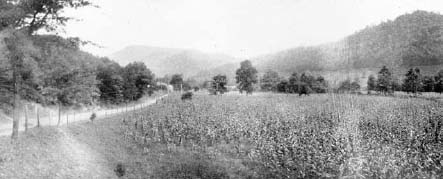
Averell's command approached the battlefield from this narrow gorge.
West Virginia State Archives
.
As the head of the Union main body emerged from the gorge, Chapman's artillery shells rained down. The sheer cliff on the right offered some protection for the horses of the dismounted men of the 2
nd
and 8
th
West Virginia, who deployed. Averell ordered the squadron of the 2
nd
West Virginia to climb to the top of the ridge to the right and a squadron of the 8
th
West Virginia to deploy on the top of the hill to the left of the gorge.
224
He also brought up a section of Ewing's battery, which immediately unlimbered and began trading counter-battery fire with Chapman's guns, quickly dismounting one of Chapman's rifled guns with its accurate and deadly fire.
225
Averell then established his headquarters just behind Ewing's guns and remained there for the rest of the day, directing the movements of his troops from that position.
226
Unfortunately, the 8
th
West Virginia somehow mistook the direction and, instead of going to the left, went to the right with the 2
nd
West Virginia, leaving the hill to the left of the gorge temporarily undefended. Colonel Oley and the balance of the 8
th
West Virginia then came up and made their way to the crest of the hill on the left. Oley reported, “We immediately dismounted and double-quicked up the hill. The enemy was found in possession of the crest of the hill, but such was the gallant and impromptu charge of my men that we quickly drove them down the hill with great confusion, killing several and wounding a number.”
227
The speed of the attack prompted a member of the 8
th
West Virginia to claim that the regiment “fought the rebels rapidly.”
228
Colonel Oley lamented the loss of two brave officers in this charge. Lieutenant John A. Morehart, a German immigrant, was killed instantly while scaling the hill when a rifle ball entered his skull through his eye socket. Captain William L. Gardner of Company E, whose company had the right of the 8
th
West Virginia's line and connected with the left of the 2
nd
West Virginia, was killed instantly by a sharpshooter's ball that passed through his head.
229
These two young men were “highly esteemed as honest, worthy men,” lamented their hometown newspaper in Gallipolis, Ohio. “From what we know of the men, their courage, energy and honorable bearing as soldiers, there is no doubt, they died as only the brave can die.”
230
In addition to these two officers who were killed, the 8
th
West Virginia suffered several other casualties during the attack on the hill.
231
